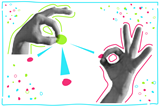When it comes to challenging your students, are you asking the right questions?

Asking students different types of questions leads them to use different thought processes. Most questions in science classrooms are closed – they have only one right answer. These kinds of questions promote lower order recall. Open questions promote higher order thinking skills and are more likely to support deep learning, but we use them less frequently.
A new research study filmed classes to explore the role of teacher questions in influencing classroom discourse. The study took place in a Danish secondary school and involved a veteran teacher with a grade 12 class (ages 18–20) of 13 students.
The researchers wanted to analyse the function and content of the teacher’s questions, and discover how the questions influenced classroom discourse.
Questioning questions
Of 449 questions in total, 39.6% related to student knowledge and included questions that probed the students’ knowledge of academic content. These questions were used across all classroom activities. They followed the I-R-E sequence, where the teacher initiates the question, students respond and the teacher evaluates the response.
‘Diagnostic’ student knowledge questions typically involved checking knowledge of a specific point by adding ‘right?’ to the end of statement. For example, ‘… the pH wouldn’t be equal to seven anymore, right?’ In one-to-one settings, these questions provided the teacher with useful information to support facilitation.
A third of questions were classified as ‘request’, broken down into ‘organisational’ and ‘practical’. Organisational questions included ‘didn’t you have an assignment where you solved that?’ These helped students integrate new content with previously learned material. Practical questions related to practical difficulties, such as technology problems, which students helped to solve.
‘Monologic discourse’ represented 11.4% of questions. This was when the teacher illustrated the train of thought when solving a problem. For example, questions like, ‘What do we have?’ and ‘What do we do next?’ The teacher typically answered these as he progressed.
The teacher used ‘clarification’ questions (10.5%) to clarify student contributions, helping them to correct procedural errors.
‘Relations’ questions (3.1%) were social in nature and improved teacher-student relations. They were usually asked during activity transitions.
‘Interaction of contexts’ questions (2.4%) were generally asked during lecture-type sessions, and linked academic content to real-life contexts. These were more open in nature, and students did not answer them well.
What does it mean for your classes?
The questions asked by the teacher were mostly closed – in line with previous studies – with the teacher dominating classroom conversations. The questioning also followed the I-R-E pattern, encouraging factual recall without promoting higher order thinking skills.
It is worth noting that the teacher in this study used genuine interactivity in his lessons. Students frequently asked ‘request’/’relations’ questions to support a collaborative teacher-student relationship.
While we may feel we do a good job with our questioning, many of us would find on reflection we also present our students with closed questions most of the time. But there are strategies that you can use to improve classroom discourse and support learning more effectively.
Small changes to how you ask questions can have big rewards. The benefits will be visible in students’ contributions to classroom conversations.
Teaching tips
- Make questions more open, for example asking ‘What do you know about amino acids?’, rather than ‘What is the structure of an amino acid?’ This discourages simple recall. But beware of using guess-what-the-teacher’s-thinking questions.
- Make opportunities for students to lead I-R-E questioning, giving them ownership over the initiation of the question and the evaluation of responses. This may take time, as students can expect teachers to take the lead.
- To overcome the problem of short answers of limited complexity, add questions such as ‘How do you know?’ and ‘How would you justify that view?’
- Give students more opportunities to link theory to context by asking questions such as, ‘Why is that a good idea?’, providing scaffolding for thinking.
References
S W Dohrn, and N B Dohn, Chem. Educ. Res. Pract., 2018, 19, 352 (DOI 10.1039/c7rp00196g)














No comments yet